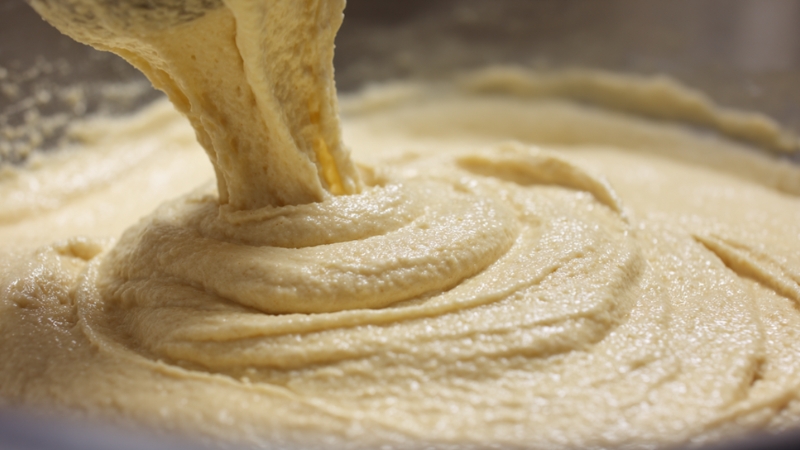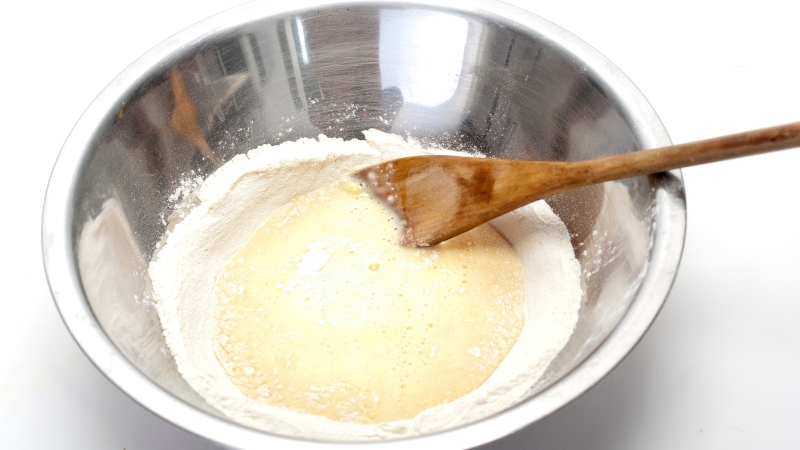The short answer is no, eating raw pancake batter is not safe. While licking the spoon or bowl is a tempting tradition for many, raw batter comes with very real health risks because of two ingredients: raw eggs and raw flour.
Both can carry bacteria that cause food poisoning, and the risks are not just theoretical – outbreaks linked to both ingredients are well documented. Cooking pancakes eliminates these dangers, but until they’re fully cooked, the batter should not be eaten.
This might sound overly cautious, especially since tasting batter is such a common childhood memory. But food safety experts stress that even small amounts of contaminated batter can be enough to cause illness.
For healthy adults, that might mean an unpleasant couple of days. For children, pregnant women, or anyone with a weaker immune system, the outcome can be much more serious.
Why Eating Raw Batter Is Risky

The Egg Factor
Eggs are the most obvious concern. Raw eggs have long been associated with Salmonella, a type of bacteria that can cause fever, stomach cramps, diarrhea, and dehydration. While farms and suppliers take steps to reduce contamination, the CDC estimates that about 1 in 20,000 eggs may contain Salmonella.
That sounds like winning a very bad lottery, but when you think about how many eggs are sold and consumed every day, cases inevitably happen.
Cooking eggs to at least 160°F (71°C) kills the bacteria, which is why scrambled eggs, omelets, and pancakes are safe once fully cooked. Until then, any mixture containing raw eggs should be considered risky.
The Hidden Risk in Flour
What surprises many people is that flour can also be a problem. Flour isn’t treated to kill bacteria – it’s just ground grain. During farming and processing, the grain can come into contact with bacteria from soil, animals, or water.
That means E. coli and other pathogens can survive in the flour bag you bring home.
Between 2015 and 2019, there were multiple flour-related E. coli outbreaks in the U.S. and Canada, leading to product recalls and hospitalizations. Because flour doesn’t get cooked until you bake or fry it, raw batter is just as risky as raw cookie dough.
What Happens If You Eat Raw Pancake Batter?
@drjencaudle Raw Cookie Dough or Cake Batter? #cookiedough #rawcookiedough #cakebatter #rawcakebatter #raw #cookiedoughrecipe #food #rawfood #drjencaudle #fyp #fyp ♬ Salsa Party 1 – Intermede Music
The result depends on whether the batter is contaminated and how strong your immune system is. Some people might get lucky and feel nothing. Others could develop food poisoning within hours to a couple of days.
Typical symptoms include:
- Nausea and stomach cramps
- Diarrhea (sometimes severe)
- Vomiting
- Fever and chills
- Dehydration
Most healthy adults recover in a few days, but children, elderly adults, and pregnant women face greater risks. In extreme cases, E. coli can lead to hemolytic uremic syndrome (HUS), a condition that damages the kidneys.
Common Misconceptions People Believe
- “It’s just a small taste, it won’t matter.”
In reality, a very small amount of contaminated food can make you sick. Pathogens don’t need a full serving to cause problems. - “Only eggs are the issue.”
Many people remove eggs from a recipe and think the batter is safe. But flour alone can carry E. coli, so egg-free batter isn’t automatically safe. - “Sugar, milk, or mixing kills bacteria.”
None of these ingredients sterilizes the batter. Bacteria can survive happily in the mixture until cooking destroys them. - “I’ve done it before and never gotten sick.”
Past luck doesn’t equal future safety. Many outbreaks happen when people least expect them.
Who Should Be Most Careful
While no one should eat raw pancake batter, some groups face higher risks:
- Children under 5: Their immune systems are not fully developed.
- Pregnant women: Risk of infection spreading to the baby.
- Older adults: Weaker immunity makes recovery harder.
- People with chronic conditions, Diabetes, cancer treatment, or weakened immunity, increase vulnerable.
For these groups, even a mild infection can become serious.
How to Safely Recreate the “Raw Batter” Experience
Missing the fun of licking the spoon? You’re not alone. Luckily, there are safe ways to make an edible pancake batter:
- Use pasteurized eggs: These are heat-treated to kill Salmonella but still behave like raw eggs in recipes.
- Use heat-treated flour: You can buy it pre-packaged or bake regular flour at 350°F (175°C) for 10 minutes to kill bacteria.
- Try egg substitutes: Flaxseed meal mixed with water, applesauce, or commercial egg replacers are safe options.
Once you use these ingredients, you can mix up a “safe-to-eat” batter and enjoy it without worry.
Health Risk Breakdown in Detail
Ingredient
Why It’s Risky
Potential Illness
How to Make It Safe
Raw eggs
May contain Salmonella
Food poisoning with cramps, diarrhea, and fever
Use pasteurized eggs or egg substitutes
Raw flour
May contain E. coli
Severe stomach illness, sometimes kidney complications
Heat-treat flour or buy pre-treated
Full batter
Both combined risks
Higher chance of illness, especially in kids and the elderly
Cook thoroughly or adapt the recipe
Cultural Side Note: Why We Love Eating Batter
View this post on Instagram
Part of the temptation comes from childhood nostalgia. Baking pancakes, cookies, or cakes often felt like a family activity, and “tasting the batter” was a reward.
It gave a sense of participation and fun. But back then, food safety risks weren’t as well understood. Today, experts are clearer: those same memories could just as easily end in illness.
Interestingly, some countries never developed the tradition of eating batter. In Japan or South Korea, for example, raw flour consumption is far less common, and outbreaks linked to it are rarer.
In Western countries, however, the habit is so ingrained that companies now sell safe “edible doughs” to satisfy the craving without the risk.
Practical Tips to Stay Safe
- Cook pancakes until the centers are no longer wet and the outside is golden brown.
- Store flour properly in a cool, dry place to reduce contamination risks.
- Wash your hands, utensils, and countertops after handling raw batter.
- Don’t let kids lick mixing bowls unless the batter was made with heat-treated ingredients.
Final Thoughts

So, can you eat raw pancake batter? No – you shouldn’t. Raw eggs and flour carry very real risks of Salmonella and E. coli, and there’s no way to tell if your particular batch is contaminated.
While it might seem harmless to sneak a spoonful, the potential consequences – days of illness or worse – aren’t worth it.
The good news is that you can still enjoy the “raw batter” experience by making small adjustments. With pasteurized eggs and heat-treated flour, you can mix up an edible version that’s fun and safe.
And once the batter hits the skillet and turns into warm, fluffy pancakes, you can enjoy them without any worries.
Hi there, my name is Kelly Barlow and kellytoeat.com is my blog. Here, I write about various recipes I want to reccommend to readers.
I try to find the best possible recipes that can attract the attention of readers, and at the same time, I strive to write it in the most engaging manner possible.
When I was younger, I wanted to become a chef. Sadly, it wasn’t meant to be, but at the very least, I write about it.
